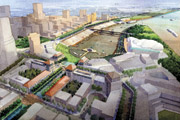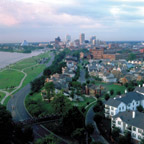Over the River
and Through Downtown
Downtown Memphis is in the midst of revitalization, led primarily
by an influx of residents drawn to the mighty Mississippi River.
Susan Hayden
 |
|
Dudas
|
|
When the Peabody Hotel closed in the early 1970s, many residents
of Memphis, Tennessee, felt as if a part of the city’s
soul was lost. So when Belz Enterprises renovated and re-opened
the hotel in 1981, residents started to gain a new interest
in the community, not only downtown, but citywide. Thus began
the revitalization of downtown Memphis, a city that was “left
for dead,” according to John Dudas, vice president with
Belz Enterprises, an active Memphis developer. But unlike
many other downtowns across the country that have undergone
revitalization in recent years, Memphis’ revitalization
has been led by residential, not commercial, development.
 |
|
Dudas
|
|
“We would like to think it’s due to a combination
of visionary developers, good planning and ample public incentives,”
says Jeff Sanford, president of Memphis’ Center City
Commission. “But in the end, I have to think it’s
the draw of the mighty Mississippi River, with its incomparable
sunsets, that has attracted so many.”
With its alluring qualities, the Mississippi River is where,
understandably, much of the development energy is being focused.
In March of 2000, the Riverfront Development Corporation, a
non-profit entity, was created and contracted with the city
to manage, operate and develop the riverfront. The group’s
master planning firm, headed by Cooper Robertson, developed
a visionary and transformational plan, and it was eventually
approved by the city council in May of 2002.
The plan’s primary objective was to get people to the
water and to provide access for those people. And the timing
was right. Before 2000, the community wasn’t ready to
face riverfront development because of the condition of downtown.
There was little to draw residents to the city or the riverfront.
 |
|
Lendermon
|
|
“We had this void of activity that existed between downtown
and the waterfront, and we wanted to take advantage of the
city’s current momentum, fill in the void, and redevelop
the area,” says Benny Lendermon, executive director of
the Riverfront Development Corporation. “We also wanted
to provide access to the waterfront that would keep downtown
from growing away from the riverfront and, in turn, spur and
increase the momentum of what was currently happening downtown.”
The overall plan for reuniting downtown and the river calls
for extending the city of Memphis out, closing a major portion
of the harbor, filling it in and creating roughly 50 acres of
land that connect to the waterfront. Additional plans include
a significant number of improvements along the 5-mile stretch
of waterfront with public access along the water’s edge
and greatly improved green space. Even as the master plan was
being finalized, improvements were taking shape. These included
construction of a cobblestone walkway along the top of the Cobblestones,
which will be renovated to once again become a landing for commercial
riverboats, and improvements to Riverside Drive, which beautified
the road, slowed traffic and provided connections back to the
city.
Also on the planning table is Mud Island. For the first
time in its history, the island will be seamlessly integrated
into the city and easily accessible from downtown by the construction
of a land bridge from Court Street to Poplar Avenue. Another
critical part of reuniting downtown and the river is the Overton
Heirs Blocks. If properly developed, the blocks will eliminate
the physical and visual barriers that now exist along the
waterfront. Mixed-use development and a well-designed street
system will encourage pedestrian traffic from Main and Front
streets to the river.
 |
|
Rendering of Memphis riverfront
master plan.
|
|
Plans also call for the downtown harbor and the lake to be
connected by a new mixed-use neighborhood. Currently the most
valuable real estate is not along the riverfront, but real
estate values are expected to increase as new addresses are
added. In fact, another factor that has contributed to the
residential boom in downtown Memphis is the availability of
open land for new construction — land that sits along
the river bluffs and riverbanks. Currently, much of the land
is devoted to railroads, parking, industrial and parkway infrastructure,
or is underutilized (Mud Island and Overton Heirs Blocks).
A number of local and national developers are already taking
advantage of the prime real estate sites — developers such
as JPI, which is putting in a 400-unit apartment project on
Mud Island, and Henry Turley Company, which has been developing
residential and commercial projects in the Memphis market since
1977.
One of Henry Turley’s developments is a New Urban neighborhood
called Harbor Town, which was established in 1989 by Island
Properties Associates — a partnership between Belz Enterprises
and Henry Turley Company.
 |
|
Turley
|
|
“One of our long-time initiatives has been working to
re-build the downtown in Memphis,” says Henry Turley.
“When we first started thinking about it around 1977,
we thought a component of a traditional city that was so clearly
missing from Memphis and from typical cities our size was
residential. So for some 20 years, we’ve focused most
of our energy on putting housing in the city.”
A planned community, similar to Seaside and Celebration in Florida,
Harbor Town is located on 135 acres of Mud Island in downtown
Memphis. The mixed-use community consists of more than 950 homes,
more than half of which are privately owned. The community features
ponds, wetlands, walking paths and parks. When complete, the
development will have 30,000 square feet of office space and
25,000 square feet of retail.
Another Belz/Turley partnership is Uptown, the redevelopment
of former public housing sites and other distressed property
just north of downtown into viable mixed-income communities.
 |
|
Downtown Memphis’ South
Bluffs residential community.
|
|
“Downtown has been reasonably successful in beginning
its redevelopment, and we hope that the proximity of the downtown
amenities and assets — from jobs to entertainment to
schools — to Uptown can become something of a seamless
situation,” notes Turley.
Uptown will include 1,000 new homes and apartments, for a range
of income levels, in a traditional neighborhood setting. A $150
million public-private partnership, including a $35 million
HUD HOPE VI grant to the Memphis Housing Authority, Uptown will
also feature new infrastructure, parks, streetlights and landscaping.
Building Boom
Since the Peabody Hotel re-opened, downtown Memphis has undergone
a building boom valued at approximately $2 billion — the
largest in downtown’s history. Residential development
is growing exponentially, both in number of units being made
available and pricing for those units. Beale Street, the state’s
Number 1 tourist attraction, has come more alive than it was
in the past — with more and more people moving into downtown.
Additionally, a number of exciting and tourist-driving projects
have been completed, including AutoZone, a $75 million Minor
League Baseball park right in the middle of Memphis, and Peabody
Place, the area in and around The Peabody Hotel. Development
of Peabody Place, which includes the expanded hotel connected
to a three-level retail and entertainment center, began in 1980
when Belz Enterprises renovated the hotel, which is located
at Union and Second streets. Peabody Place covers eight city
blocks between Fourth Street and Riverside Drive and totals
more than 2 million square feet of office, residential, hotel
and retail space. The Peabody Hotel anchors the north end of
the project, and the 265,000-square-foot AutoZone corporate
headquarters anchors the west end. The Peabody Place Entertainment
and Retail Center is located at the east end and includes more
than 30 specialty shops, restaurants and entertainment retailers,
such as Jillian’s, Isaac Hayes restaurant, Ann Taylor Loft
and Victoria’s Secret; a 22-screen theater; and access
to the Number 1 Hampton Inn and Suites in the world (designed
to be like a mini Peabody Hotel).
Downtown’s Main Street is getting a makeover.
“We’ve had $2 billion worth of development, yet if
you came to Memphis, having never been downtown, and walked
along the six blocks of the traditional Main Street, you would
find a street virtually untouched by this renaissance,”
says Sanford.
So the Center City Commission created a Main Street redevelopment
plan. To start the redevelopment, the commission has concentrated
efforts on one demonstration block for the last 2 years —
this is the block between Union and Gayoso, where private sector
developers have, at various times, made attempts to assemble
property but were thwarted in their efforts.
“In the last 2 years, we’ve managed to gain control
of most of the properties we set out to gain control of, and
we have been successful in optioning properties to private developers,”
says Sanford. “Now tens of millions of dollars worth of
construction is about to get underway, and the face of this
block will change dramatically.”
Development will mostly consist of retail at ground level and
residential above. As the Center City Commission had hoped,
the Union/Gayoso block is already starting to spark the interest
of private developers in the adjacent blocks on Main Street.
To attract developers downtown, the Center City Commission creates
partnerships to implement projects and administers financial
incentives that can help lower development costs. One such program
is called PILOT, which allows developers to improve or stabilize
a property through building renovations or new construction
while freezing real estate taxes at the current predevelopment
rate.
“Success attracts success,” says Sanford, “so
we’re in the fortunate position right now of being approached
from all sides by developers — local as well as regional
and national — that are interested in various projects.”
At the moment, the Commission is in discussions with developers
about several hundred million dollars worth of projects, which
range from hotel and residential to office and commercial ventures.
A number of smaller developers are buying historic buildings
and renovating them for housing and a few new construction projects
are being built, primarily by smaller developers as well.
One of the other characteristics of the residential redevelopment
downtown has been the conversion of vacant office buildings
into residential and hotel properties, such as Capital Development’s
market-rate project called 10 Main Street.
“We are just now seeing some signs of life in office development,”
Sanford says. “It wasn’t strong, and whatever sparks
we saw were sort of hemmed by economic conditions, but now it’s
starting to appear again.”
But downtown Memphis is clearly headed in the direction of residential.
“What we really see as our future for downtown is continued
housing development,” says Dudas. “We have a very
strong demand for housing. We also see continued emphasis
on sporting and entertainment venues and building our tourist
base. But the continued housing development, with great rental
rates and high occupancy rates, has been a major factor in
the success of downtown.”
©2003 France Publications, Inc. Duplication
or reproduction of this article not permitted without authorization
from France Publications, Inc. For information on reprints
of this article contact Barbara
Sherer at (630) 554-6054.
|
